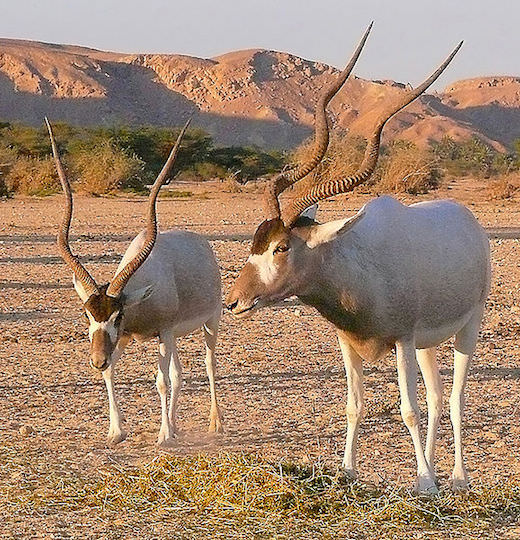Addax

Critically endangered
Addax is an antelope that is also known as a white antelope or screw horn antelope due to its twisted horns. It was first described by Henry Blaiville in 1616 and its name has an Arab origin and it means a wild animal with crooked horns. Another name used for this specie is a French term Antelope Blanche which means White Antelope.
The Addax is a desert dwelling animal and it is naturally well adopted for harsh conditions of desert. Addax can also live in the stony environment. They are herbivores just like other antelopes. The animals are nocturnal creatures which help them avoid predators and males are very territorial and their task is to safe guard the females. The structure of the herd is based on matriarch that means the oldest female is a leader of the herd and it takes the herd to the places with best vegetation. The color of short coat is grey-brown during the winter and it turns to white.Their hooves are specifically splayed so the animal can move easily across the desert.
The Female specimen of the herd is smaller than the male one as it can vary from 60 to 90 kg (130-200lb) while the weight of the male specimen can be from 100 kg to 125kg (220-276lb.).This is a really impressive fact and it helps the Addax in its fight for survival. The body length can vary from 105 to 115 cm (41-43 inches) and from 95 to 110 cm (37-45 inches). The horns are quite magnificent and both female and male Addax have them. The longest recorded length of the horns is 109.02cm(43 inches).Their teeth are different than teeth of all the other antelopes as they look more like the teeth of cattle and it helps the digest the food better and faster. Males reach sexual maturity at age of three while female reach it much sooner at one year and half months. It takes up to 8 or 9 month for a new Addax to be brought to this world. They can live up to nineteen years in wild and twenty five years in captivity.
Population Distribution
Addax could have been found all across Northern Africa inclosing both sides of Sahara desert from west to the east of this part of Africa. Addax can be found in only Niger and Chad and maybe along the border of Mali and Mauritania. Only five hundred wild specimen are left. It might be even possible that there are less than 200 Addax left in the wild. Most of them are located in the Niger while the smaller part maybe of 100 or less are in Chad. Northern Sudan had a significant number of this beautiful animal but the unstable political situation made protection of the Addax hard. The government of Morocco plans to resettle Addax from Massa National Park to Dakhla National Park. The same strategy is implemented by Algeria so we might see the growth of Addax in its natural environment.
Threats
The greatest threat to Addax is a man as locals hunt them without any limits or supervision. Addax are slow moving animals so they are easy targets for hunters in their jeeps armed with modern weaponry. Their habitats are often being destroyed to make more for more farming or residential land. There are also natural factors such as droughts and desertification.